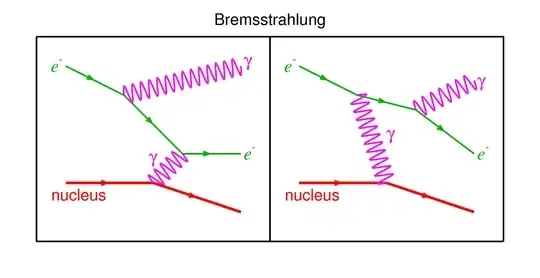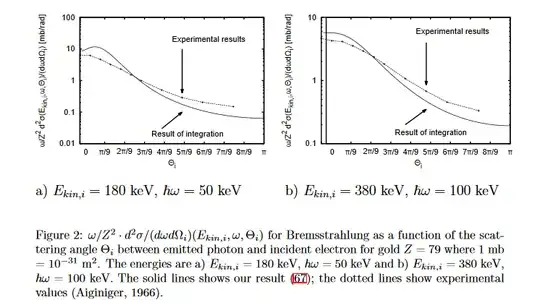When an electron loses energy and emits a photon, what determines the direction that this newly-created photon will travel? The electron, being a point entity, has no internal physical structure, so I'm assuming the photon's motion is inherited from the motion of the electron at the instant when the photon was emitted?
4 Answers
Electrons and photons are quantum mechanical entities and obey solutions of the appropriate quantum mechanical equations.
When an electron loses energy and emits a photon,
The "loses energy" already describes an interaction: it is called bremsstrahlung
what determines the direction that this newly-created photon will travel?
The calculation of these Feynman diagrams
will give the probability distribution that the photons will have to obey. Remember in quantum mechanics it is the probability distributions that are strictly determined. Individual scatters/events conform to that distribution.>
The electron, being a point entity, has no internal physical structure, so I'm assuming the photon's motion is inherited from the motion of the electron at the instant when the photon was emitted?
No , it is random BUT obeying energy momentum conservation AND the accumulation of these events has to follow the calculable probability distribution. If the probability distribution peaks in the direction of the incoming electron a sampling of one scatter will probably fall in that region, but there is a probability that it may have a larger angle. Thus it will depend on the conditions assumed . The "nucleus" in the diagram may just be an electric or magnetic field .
In this paper the calculations are done for high energy electrons and positrons in storms , to estimate the gamma (high energy photons) emission.
So the probability distribution for angular effects has a bias towards the incoming electron , but there is an appreciable probability with larger angles, in the solution of this specific problem.
- 236,935
Perhaps one needs to provide some context. The OP does not specify a free electorn or bound electron. If the electron is bound in an atom, then the spontaneous radiation of a photon would occur when the electron moves from an excited state to the ground state, for instance. In such a case the direction of photon emission is completely random. It simply occurs because the excited state is unstable and there is no way to predict to direction.
Another scenario is compton scattering. Here a photon is first absorbed by the electron and then another photon is radiated by the electron. If one would ignore the absorption of the first photon, one would think that the electron just spontaneously emitted a photon. However, neither of these two event can be considered in isolation, because neither of them can in general conserve energy-momentum. So one would need to consider the whole process. In that case, the direction of the emission is governed by the condition of the initial photon and electron prior to the absorption of the first photon. One can compute the propability distribution for all the possible directions that the last photon can be radiated.
There are many other scenarios, however, they can all be considered in a similar way as these two scenarios.
- 16,824
you'd better think in terms of 3d waves, the electron has an electrical field, when it moves that creates a special 3d shaped wave related to the direction of oscillation(shape here). That 3d wave is light/EM radiation, and you'll get a photon where light is caught.
- 1,624
The direction of the photon is simply determined when it is measured, just like everything else. The reason for this that everyone seems to ignore is that, from the photon's perspective, it is everywhere in the universe simultaneously the moment it is emitted. This explains wave-particle duality. Remember from general relativity that entities traveling at light speed are orthogonal to the space dimensional vector and, from their perspective, have zero time component. In other words, distance per unit of time approaches infinity and their time per unit of distance is zero. Or, more simply put, from the point of view of the photon, it travels across the entire universe instantaneously. Because the moment of emission and the moment of measurement are the exact same moment, there is no opportunity to contemplate such a thing as "direction". The photon reaches all observers in all locations in the universe at exactly the same time regardless of distance from point of emission. Because of this, the photon is a wave from the point of view of the observer but it is a point particle from its own point of view. Structurally, looking from the outside, one could describe the photon as a field. This reframing explains all sorts of things such as the double slit experiment, quantum teleportation, and has the potential to reconcile relativity and quantum mechanics. If the mathematics is reworked from the photon's perspective, there is no need for things like "probability waves" and such. Quantum collapse and relative motion, both emergent effects of observation, stem from the same underlying phenomenon.
Update: I see downvotes and statements about inaccuracy, but no statements supporting those opinions or refuting mine.
- 11
- 1

